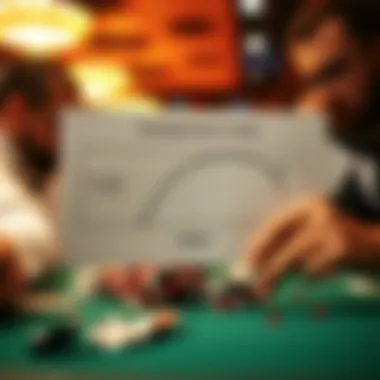Mastering the Art of Calling in Poker Strategy


Intro
In the realm of poker, the concept of calling transcends basic gameplay mechanics. To consider calling simply as the act of matching a bet would be to overlook its depth and nuance. It embodies a blend of strategy, psychology, and situational awareness that can make or break a hand. Understanding calling is not just instrumental for winning; it’s essential for developing a robust poker identity and skill set.
This article constructs a roadmap for players of all experience levels. We're diving into how calling fits into broader poker strategies, including an analysis of the different player types and their tendencies. We will also examine the psychological underpinnings of decisions at the table and investigate scenarios where calling may turn the tide in your favor.
Key Points to Be Discussed:
- The mechanics and fundamental principles of calling.
- Psychological aspects that influence decision-making.
- Strategic implications based on position at the table.
- Various gameplay scenarios where calling is critical.
- Optimal strategies for different player types.
By encompassing these elements, readers will gain a clearer view of not only how to play the hand but also why they might choose to call—empowering them to make informed, effective decisions in their poker journey.
Defining Calling in Poker
In the realm of poker, the act of calling is more than a basic move; it serves as a fundamental building block of strategy and decision-making. Understanding what calling means and the implications it carries can significantly enhance a player's ability to navigate the complexities of the game. Every poker enthusiast, from amateur to seasoned player, should be well-versed in the concept of calling because it plays a crucial role in determining outcomes, controlling pot sizes, and even psychological warfare against opponents.
Basic Explanation
At its core, to call in poker means to match the current bet made by another player. This action allows a player to stay in the hand instead of folding or raising. Imagine you're at a tense table, the stakes are high, and the atmosphere thickens with anticipation. When a player calls, they are essentially saying, "I believe my hand is strong enough to continue, or I've got something worth challenging your bet." It's a pivotal moment that can dictate the flow of the game, especially in later betting rounds.
Calls can reflect various strategies. Players may call to see another card, hoping to hit the hand they desire. Alternatively, they might think that their current hand is strong enough to win at showdown. Whatever the motivation, the decision to call is often influenced by a blend of factors including pot odds, player reads, and position at the table.
Terminology and Overview
Familiarizing oneself with the terminology surrounding calling is essential for any player. Here are a few key terms that are often woven into discussions around calling:
- Call: For the layperson, this simply refers to matching the bet. However, for advanced players, this may also mean understanding the mathematics behind it.
- Face-up Calls: In a casual setting, one might refer to someone making a call while showing their cards as a face-up call, often a strategic display.
- Cold Calling: This term defines the act of calling a raise (or multiple raises) when entering the action.
- Check-call: A player may check on their turn and then call a bet when the action moves back to them.
Understanding these terms creates a foundation for analyzing calls more critically. The importance of calling should never be underestimated. It can signify a player's willingness to engage while also revealing much about their strategy and confidence in their hand.
"In poker, the calls you make speak volumes about your strategy and mindset."
Ultimately, mastering the art of calling requires not just an understanding of the mechanics but also an appreciation of timing, context, and the ever-evolving dynamics at the table.
The Mechanics of Calling
Understanding the mechanics of calling is like knowing the rules of the road before you take a drive. It’s foundational, yet intricate. Calling isn’t just about matching a bet; it's about assessing situations, evaluating positions, and sometimes playing a mental game. This section will break down how calling operates in poker, its profound importance, and the nuances that distinguish it from other actions.
How Calling Works
In poker, to "call" means you’re putting in the same amount of chips as the last player did. It’s a decision made during a betting round after assessing an opponent’s move. When you call, you are effectively saying, "I think I can continue with my hand and want to see the next card or round without increasing my investment." What lies beneath this apparent simplicity?
- Evaluating Your Hand: Before making a call, players often weigh the strength of their hand against the perceived strength of their opponent's hand. This involves basic hand calculations and the odds of hitting a favorable outcome on future streets.
- Understanding Table Dynamics: It’s crucial to consider not just your cards but the table's atmosphere. Is the mood aggressive, or are players conservative? Your decision can hinge on this, where you might call to gather more information or throw a wrench in the tactics of more aggressive players.
- Pot Odds and Expected Value: When deciding whether to call, pot odds come into play significantly. Simply put, if the money in the pot is worth more than your risk of calling, then it often makes sense to proceed. Understanding the risk-reward ratio is vital for long-term success in your poker journey.
"Calling doesn’t just exhibit a ready hand; it can showcase your depth of strategy."
Differences Between Calling and Raising
Understanding the stark contrast between calling and raising is fundamental for any serious poker player. Each has its place in a well-rounded strategy, influencing the flow of the game.
- Intent and Position: When you call, you're generally agreeing with the current state of play. You're not trying to push an agenda. Raising, on the other hand, sends a signal: you believe your hand is stronger and want to leverage that strength. The position at the table also plays a critical role. Being first to act means a raise might intimidate opponents, while a call may allow you to scope out the competition before committing more chips.
- Size of Commitment: Calling requires a straightforward commitment, while raising asks for a larger investment up front. In certain scenarios, especially in cash games, this impacts your overall stack management strategy.
- Psychological Consideration: It’s also a tale of mind games. A raise can put pressure on others, known as putting them to the test. Calling might imply either interest in the hand or a feigned weakness—thus, your opponents could misinterpret your intentions.
In sum, calling and raising are tools in your poker toolkit, each providing unique angles of attack and defense. Mastery here isn't simply enough; understanding the timing and context of when to apply each can set the stage for great performance at the tables.
As you dive deeper, remember that every call is a decision influenced by many factors, internal and external. Keep an eye on the larger strategy at play, and in doing so, turn routine calls into pivotal moments in your poker narrative.
The Psychology of Calling
Understanding the psychology behind calling in poker is essential for players seeking to master the game. Unlike more straightforward actions like raising or folding, calling involves a deeper level of emotional and psychological engagement. It’s not just about the cards; it’s about weighing risk against potential reward while simultaneously acknowledging one’s own emotional state and that of the opponents at the table. Players must navigate layers of complexity related to their personal motivations and strategic considerations, which makes calling a fascinating facet of poker gameplay.
Emotional Factors in Decision Making
When considering a call, emotions play a crucial role. Players often face a mental tug-of-war, balancing their gut feelings against logical reasoning. For instance, a player might feel confident about their hand based on previous rounds, creating a strong urge to call even when the odds might suggest otherwise. This emotional impulse can lead to poor decision-making, particularly under pressure. Conversely, a player might experience anxiety when faced with a hefty bet, causing them to second-guess their instincts and potentially miss a opportunity for a well-timed call.
Common emotional pitfalls and factors that influence calling include:


- Fear of Loss: The unpalatable taste of losing can lead players to fold even when calling might be the better option. This anxiety often stems from previous bad beats, creating a fear that clouds judgment.
- Desire to Save Face: In social settings, the fear of embarrassment can override logical thinking. Players may feel compelled to call to appear more aggressive or competent, even if the math isn’t on their side.
- Confidence Levels: A winning streak can pump up confidence, prompting players to call bets they normally wouldn't, thus risking their stacks on subpar hands.
Reading Opponents: The Mind Game
Poker is often touted as a game of incomplete information, and this adds an intriguing psychological layer to calling. Players must adeptly read the intentions and emotions of their opponents, not just the cards on the table. Understanding an opponent’s betting patterns, body language, and past behaviors helps in making informed decisions about calling.
Effective reading involves paying attention to cues that might indicate strength or weakness. For example, if an opponent who’s typically passive suddenly makes a large bet, it may suggest they’ve hit something substantial. Players should be like detectives, piecing together the slight hints that reveal truths about their opponents’ hands.
Key aspects in reading opponents include:
- Betting Patterns: Consistency or inconsistency in betting can signal confidence in one’s hand or feature tactics to bluff.
- Physical Tells: Non-verbal cues such as sweating, fidgeting, or sudden changes in posture can indicate nervousness or overconfidence.
- Psychological Profiles: Some players thrive under pressure while others wilt. Recognizing these tendencies can help balance the decision to call with the potential risks involved.
Employing psychological strategies effectively in calling not only enhances decision-making skills but also elevates the overall poker experience, transforming it from a game of chance to a calculated war of wits. Understanding how to read opponents and manage personal emotions can set successful players apart from the rest, ultimately leading to greater success at the tables.
The ability to decipher the interplay of emotion and strategy in calling is essential; it is what separates amateur players from seasoned veterans.
In summary, understanding the psychology behind calling involves emotional intelligence and keen observation skills. Players who hone these aspects will find themselves making more informed decisions, showcasing a deeper comprehension of the game’s nuances.
Situational Aspects of Calling
In poker, understanding the situational aspects of calling is crucial for a player aiming to refine their strategy. The decisions you make at the table often hinge on various situational factors, which can heavily influence not only the outcome of a hand but also your overall game. By being aware of your surroundings and analyzing the dynamics at play, you stack the odds more in your favor.
Position at the Table
Your position at the table plays a significant role in determining whether calling is a wise choice. In essence, position refers to where you sit relative to the dealer button, which affects the order of play. Being later in the betting sequence can be a leverage point.
For instance, if you're seated in a late position, you have the advantage of observing the actions of your opponents before making your decision. If they are aggressive and have been raising frequently, you might opt to call with a wider range of hands because you can better gauge the strength of their bets. Conversely, in an early position, caution is advisable; calling with marginal hands can quickly lead to trouble as players behind you may raise the stakes.
Moreover, the importance of position isn’t just about where you sit. It also intersects with the types of hands you should be playing based on your table dynamics. If the players at your table are passive and tend to check or call, you might find opportunities to call down with weaker hands, knowing that the pot could still be worth investing in.
Accessible resources on poker positions can be found on platforms like Wikipedia and poker strategy forums on Reddit.
Table Dynamics and Calling Trends
Table dynamics are another cornerstone in assessing when to call. The vibe at the table can change rapidly, with different players exhibiting unique styles. For example, some tables might be populated with loose players who play many hands and tend to call often, while others might be filled with tight players who only engage in strong hands. Recognizing these trends can be an essential part of developing your strategy around calling.
When players are more inclined to chase after pots without strong hands, it opens up chances for you to call with decent holdings. If you sense a player consistently overvaluing their hands, making calls against them might yield dividends. On the flip side, if players are more reserved, you want to consider tightening your calling range because bluffing opportunities will be fewer.
"Understanding your table is like reading a good book; the plot thickens when you recognize the characters and their motives."
To better gauge these table dynamics, it's beneficial to remain observant and take notes about betting patterns. Are players more conservative during certain times of the night, or does there seem to be a full-court press on pots? When you track these trends, you will become noticeably more adept at determining the right moments to call.
Relevant links for further reading on table dynamics include Britannica and community discussions on strategy available through platforms like Facebook.
Bet Sizing and Its Influence on Calling
In poker, the size of a bet carries weight far more than just dollars and cents. Understanding bet sizing and its influence on calling is essential for any player looking to sharpen their game. It’s not merely about having a good hand; it’s about knowing how much to risk, when to stay in the game, and how your decisions can affect overall betting strategies.
When players make a decision to call, they are weighing the potential reward against what they need to invest. This dynamic makes bet sizing an influential factor since it informs decisions about whether to call, fold, or raise. If your opponent throws in a hefty bet, it may signal strength, pressuring you to reconsider your playing cards. On the flip side, a smaller bet could entice you to stay in the game, worrying less about going bust while still chasing your potential win.
The core idea here is to communicate effectively through bet sizes. A well-timed, calculated bet can convey strength or draw out weaker hands. So, in essence, properly understanding bet sizing can elevate your game from mere gameplay to strategic wizardry.
Understanding Pot Odds
Pot odds play a significant role in how players assess their calling decisions. Essentially, pot odds are the ratio of the current size of the pot to the size of the bet you need to call. This calculation invites you to analyze whether the potential reward justifies the risk.
For example, imagine a pot with a total of $200, and your opponent bets $50. Here, your pot odds would be 200:50, or simplified, 4:1. To decipher if calling is wise, you must compare these odds to your chances of completing your hand. If you estimate that you have a 20% chance of winning, then your decision becomes clearer. In this case, the pot odds are favorable, making the call attractive.
The following provides a quick view of how pot odds inform your call decisions:
- Calculate the Pot Odds: Understand the ratio based on the pot size and bet.
- Assess Your Hand’s Chances: This involves estimating your likelihood of completing a winning hand.
- Make the Call if Favorable: If pot odds offer a better chance than the odds of winning your hand, it might be time to stay in the game.
Evaluating Bet Size Preferences
When it comes to betting, not only the size matters, but also the preferred range of bets can change the entire pace of the game. Player tendencies often guide how one evaluates these preferences—some people lean towards aggressive betting while others take a more cautious route.
Understanding a particular player’s bet size preferences may give you an edge. For instance, if you notice that a player tends to go all-in relatively often, a call in response might carry risks of a high-stakes duel. Conversely, if a player tends to make smaller bets, it might indicate a weaker hand or a cautious strategy.


Furthermore, how one adjusts based on position at the table can further complicate evaluations:
- Early Position: Players here often bet smaller to gauge reactions.
- Late Position: Players might size their bets larger to assert dominance.
- Bluffing Opportunities: Smaller bets might be used as bluffs to trick opponents into a false sense of security.
In essence, recognizing and adapting to these bet sizing habits can help refine not just your calls but enrich your complete poker strategy. Efficient players know that understanding variations in bet sizing can tilt the odds in their favor, leading not just to better calling decisions but overall enhanced gameplay.
"In poker as in life, understanding the subtleties of communication can lead to the most profitable outcomes."
Acquiring skill in interpreting and manipulating bet sizes will bring significant improvements to your calling game, enriching your overall experience at the tables.
Common Misconceptions about Calling
In the world of poker, calling is often misunderstood. Many players, especially newcomers, view calling as a subpar strategy that signals weakness. This article breaks down the misconceptions surrounding calling, highlighting its strategic importance and providing insights into the psychological and situational factors that play a crucial role. Misjudging the value of calling can lead to poor decision-making, which ultimately impacts overall gameplay. It's essential to navigate these misconceptions and understand when calling can be a powerful tool.
Calling as a Weak Play
The idea that calling denotes a weak play is a fallacy that persists in poker circles. While it can be true in certain contexts, viewing calling through this narrow lens ignores the broader strategy involved in assessing hands and opponents.
Many seasoned players know that calling can be a calculated move. For instance, if you’re sitting on a flush draw waiting for one more card to make your hand, calling may be the best decision, especially if your opponent is betting aggressively. At this point, a raise could scare them off or signal that your hand is not strong enough to warrant the risk.
Some common scenarios where calling is misinterpreted as weakness include:
- Early betting rounds: Players tend to think that those who call rather than raise lack confidence. However, this can be an astute way of gauging how others react without committing too many chips.
- Situational poker: In tournament scenarios, where chip preservation is crucial, a call might be more prudent than a bluff or raise. The risk of losing a significant portion of your stack outweighs the potential gains.
Ultimately, labeling calling as a weak move oversimplifies its role in the game. It can often be a strategic play that calculates risk versus reward effectively.
Recognizing Strong Calling Scenarios
Understanding when calling is strong is key to advancing one’s game. Strong calling scenarios are nuanced and vary based on table dynamics, the tendencies of opponents, and the specifics of the game type. Recognizing these situations can significantly elevate one’s overall strategy.
Here are a few strong calling scenarios to consider:
- Favorable Pot Odds: When the pot is offering good odds relative to the size of the bet, a call can be a rational choice. Imagine you only need to put in a small amount to potentially win a large pot. In these instances, calling is often a sound decision.
- Reading Opponents: If you sense that an opponent is bluffing or not fully committed to their bet, calling can be a way to capitalize on that weakness. A well-timed call can put pressure on the aggressor and reveal their true intentions.
- Drawing Hands: Like before, if you hold a drawing hand, particularly for straights or flushes, calling is often preferred to raise. Your objective is to see more cards without scaring away the robust options that come with a big pot.
Strategies for Effective Calling
Effective calling in poker is not about just making a decision to stay in the hand; it requires a strategic approach that takes various factors into account. Players often underestimate the significance of calling, viewing it simply as a passive move. However, developing solid strategies for calling can greatly enhance a player's ability to control the game and make profitable decisions.
Identifying When to Call
Understanding when to call is fundamental to mastering poker. Several factors should guide this decision:
- Hand Strength: Assessing the strength of your current hand relative to your opponents’ is crucial. If your hand is strong enough to compete but not stronger than a potential raise, a call can be the right move.
- Table Position: The position at the table greatly influences calling decisions. Being in a later position allows for more information about the actions of others, providing clues to whether calling is advisable.
- Opponent's Bet Sizing: A larger bet often signals strength, whereas smaller bets might suggest weakness or a draw. Paying attention to this nuance can help decide whether to call or fold.
- Player Tendencies: Understanding how your opponents play can help in making a call. If someone is known for bluffing, a call might be warranted, while against a conservative player, it might be best to stay cautious.
With these considerations in mind, the art of calling starts to become clearer. Each decision should be like a finely tuned instrument, played at the right time and with the right strategy.
Balancing Calling with Other Actions
The balance between calling, raising, and folding creates a dynamic gameplay. It’s important not to become predictable, as this can be harmful. Here are a few strategies to balance calling:
- Mixing It Up: Don't only call with premium hands. Occasionally calling with lesser hands can keep your opponents guessing, preventing them from easily reading your strategy.
- Context Matters: Different scenarios may call for distinct approaches. In a loose and aggressive game, calling with a wider range might be beneficial, whereas in a tight game, it could make sense to call less often and conserve chips.
- Building Pot Control: When opting to call, particularly with a drawing hand, management of pot size is essential. Avoid inflating the pot too much if you’re uncertain about winning, and aim for a value-centered approach that maximizes potential gains if you hit your draw.
"In poker, you must learn to leave all your inhibitions at the door. Every hand is a new opportunity, and every call can be a stepping stone or a stumbling block."
Balancing calling with aggressive plays like raising does require practice and patience. The goal should always be to enrich your game while keeping your opponents on their toes, ensuring that you are constantly adapting your strategy based on the evolving dynamics of the game.
By honing these strategies for effective calling, players can better navigate their poker journey, making well-informed decisions that contribute to their overall success. Understanding the subtleties and nuances of calling transforms this action from a mere choice into a tactical and integral part of their gameplay.
The Role of Calling in Different Poker Variants
The act of calling is not just a mundane decision in poker; it plays an intricate part across various game formats, shaping strategies and influencing outcomes in fundamental ways. In poker variants, the nuances of calling adapt to specific dynamics and rules that create diverse environments for players. Understanding these variances helps refine strategies and enhances overall gameplay.
No-Limit vs. Fixed Limit
When discussing calling in poker, the difference between no-limit and fixed-limit games takes center stage. In a no-limit game, players have the liberty to call any amount of the current bet, which can escalate quickly into substantial sums. This ability fosters an environment where the emotional component of calling becomes amplified, often leading to high-stakes decisions under pressure. This volatility can be a double-edged sword; while it allows for potential large gains, it also opens the door to significant losses.
- Pros of No-Limit Calling:
- Cons of No-Limit Calling:


- Flexibility in bet sizing allows for strategic aggression.
- Decisions based on pot odds can lead to lucrative payouts.
- Risk of losing large stacks can be daunting.
- Emotional swings can impair judgment.
Conversely, in fixed-limit games, the maximum amount that can be bet or raised is pre-defined. This structure simplifies decision-making, as the stakes remain more controlled. However, players must be meticulous in their evaluation of calling, as the limited escalation restricts opportunities to leverage larger pots. Here, the strategy shifts toward patience and value betting instead of leveraging emotional highs and lows.
- Pros of Fixed Limit Calling:
- Cons of Fixed Limit Calling:
- Predictable betting structures reduce volatility.
- Easier to manage bank roll amidst small increments.
- Missed opportunities for significant winnings can occur.
- Encourages a tighter, more conservative playing style.
The Importance of Calling in Tournament Play
When it comes to tournament poker, calling takes on unique dimensions, driven by factors such as chip stack sizes, blind levels, and the ever-looming pressure of elimination. Players often find themselves in situations where a call can define the trajectory of not just one hand but their entire tournament run. With increasing blinds, the management of short stacks versus larger stacks becomes critical, and making wise calls can be the linchpin of success or failure.
In tournament play, recognizing the right time to call is crucial, especially when facing aggressive opponents who might deploy varying strategies. Here are key considerations regarding the role of calling:
- Survival: Making strategic calls can help a player stay alive in the tournament, preserving valuable chips.
- Exploiting Opponents: Calling can also serve as a defensive measure against overly aggressive plays, allowing players to capitalize on others’ mistakes.
- Stack Management: Understanding stack dynamics—how deep or shallow one’s stack is relative to others—can influence calling decisions significantly.
Calling in tournaments demands a keen awareness of timing and positioning as the implications of each call resonate throughout the entire game.
"The right call in poker can mean the difference between just playing and truly competing for victory."
Ultimately, whether in a no-limit cash game or a no-holds-barred tournament, the role of calling needs to be scrutinized and understood. Each variant presents different opportunities and challenges; adept players analyze these contrasts deeply and adjust their strategies accordingly. This meticulous approach not only prepares them for the situational aspects of calling but also lays a solid foundation for long-term success in poker.
Analyzing Post-Call Scenarios
In poker, every decision made at the table can echo through the rest of the game, especially when it pertains to calling. After a player has made a call, it's crucial to dive into the ensuing scenarios — this analysis is the linchpin for refining strategies and enhancing overall play. Analyzing post-call scenarios not only sheds light on immediate outcomes, but also aids players in understanding potential future implications based on their decisions. This part of the game digs deep into elements like opponent tendencies, board texture, and player stack sizes.
When a player calls, they essentially commit their chips to a particular hand while preserving the potential to fold later. This brings about a myriad of possibilities that can unfold on the turn and river. Thus, understanding these factors can lead a player to make more informed choices as they navigate the complexities of poker.
Evaluating Turn and River Decisions
Every player has faced this moment; the cards are turned over, tension mounts, and decisions need to be made. The turn and river cards can dramatically alter the state of play. Evaluating these cards following a call carries significant weight. It's about understanding what the board signifies and how that aligns with one’s own hand strength.
For instance, if the flop shows two hearts and the turn reveals a third, any subsequent calls need serious thought. Does your opponent represent a flush draw? Or maybe they appeared weak on the flop but are now taking aggressive actions? Observing betting patterns and sizing on the turn can clarify where everyone stands. Analyzing turn and river decisions will often separate the good players from the great ones.
- Assess Board Texture: Understand how the new cards interact with potential hands. Are there straights, flushes, or even two-pair combinations possible?
- Re-evaluate Your Hand: Has the value of your hand increased or decreased? Take time to gauge your options.
- Consider Opponent Behavior: Their previous actions can give insight into whether they are bluffing or holding a strong hand.
The Impact of Calling on Overall Strategy
The nature of calling reverberates through a player’s broader strategy. Calls aren't just singular decisions; they mold future interactions. Effective calling requires foresight and an adaptable mind.
The essence of calling lies in its ability to balance aggression with caution. Players who lean heavy on calls have to tread carefully, as it can lead to a predictable pattern. If a table knows a player is more of a caller than a raiser, they may exploit that pattern, particularly in multi-way pots. Knowing when to call influences not only your own future plays but also how others perceive your game.
- Balance Your Play: A strategic blend of calls with aggressive raises can keep opponents guessing.
- Integrate Read Skills: Combine the act of calling with keen observation skills. The poker table is as much about reading people as it is about the cards.
- Adapt Strategies Based on Stack Sizes: Short stacks might have to reevaluate calling compared to deeper stacks. The context should dictate your strategies.
In summary, analyzing post-call scenarios enhances decision-making and broadens a player's strategic horizon. By examining turn and river decisions critically, and understanding the cascading effects of calling, players can cultivate a more profound grasp of the game that goes beyond the cards themselves.
Culmination on the Role of Calling
The concept of calling in poker is paramount. It's not merely a reactive decision; it’s a calculated choice that can significantly influence the outcome of a hand. The importance of calling goes beyond just matching a bet; it embodies the essence of strategy, psychology, and position at the table. In this article, we’ve explored how calling interacts with various elements such as bet sizing and table dynamics, exposing the various layers that contribute to making effective decisions.
In the heat of the moment, understanding when to call can often be the difference between a win or a loss. This decision holds the power to either safeguard your stack or allow you to capitalize on an opportunity presented by your opponents. Here are some vital points to summarize:
- Psychological Warfare: Distinguishing between a bluff and a genuine hand is an intricate dance. The psychological dimension of calling means players must analyze their opponents carefully, weighing their likelihood to follow through with a bet.
- Optimal Timing and Position: Where you sit at the table significantly influences your decision-making process. In early positions, a cautious approach may be wiser, while later positions can afford more aggressive plays by leveraging previous bets.
- Strategic Adjustments: The dynamics of calling change based on the game's pace and your opponents' tendencies, meaning adaptability is key. A solid understanding of these shifts can help a player refine their strategy, ensuring they call at the right moments for the most favorable outcomes.
- Misconceptions Debunked: One of the biggest myths is that calling is synonymous with weakness. However, when utilized effectively, it can reveal strength and breed uncertainty in opponents.
- Reflection on Past Actions: Post-call scenarios require players to dissect their decisions. Evaluating how a call impacts subsequent turns can sharpen overall strategy and improve future decision-making.
"A well-timed call can call your opponent's bluff or force them to make a mistake. It’s both an art and a science."
Ultimately, calling is a fundamental aspect of poker that deserves careful consideration as part of a larger strategy. As we summarized, mastering it demands practice, patience, and a willingness to learn from every hand played.
Summarizing Key Insights
Bringing all points together, one can see that calling functions as a bridge between passive and aggressive strategies. Rather than viewing calling as merely a defensive play, it’s beneficial to perceive it as a strategic instrument that can be honed over time. The nuances discussed—such as psychological warfare, timing, and situational adjustments—reflect how interconnected this action is with the broader game. Players who refine their understanding of these aspects typically find more favorable outcomes at the table.
Final Thoughts on Strategy Development
As players develop their skillset, integrating calling into a holistic poker strategy becomes crucial. It's less about adhering to fixed rules and more about adapting to numerous factors—table position, opponents' behavior, and game state. Developing a keen sense for when to call will distinguish novice players from seasoned pros. By viewing each hand as an opportunity to learn, players can improve their tactical repertoire.
In summary, treat calling not just as a phase of play, but as a valuable skill to master.
For further reading and insights on poker strategies, consider visiting Wikipedia's poker page, or explore engaging discussions on this topic over at Reddit.



